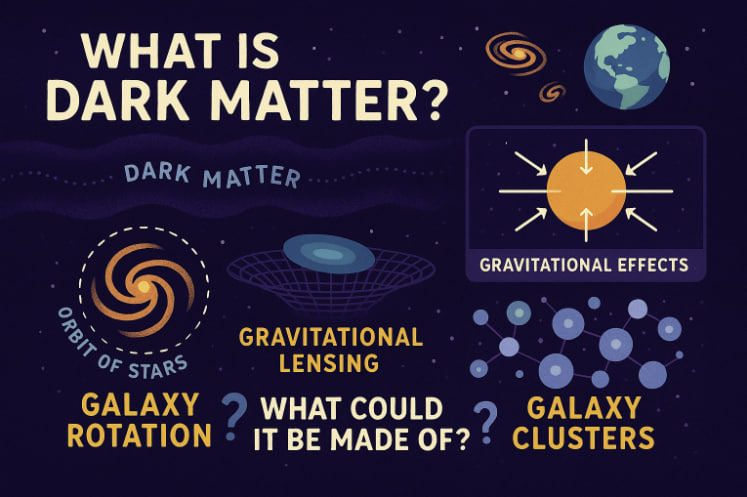Dark matter is one of the greatest mysteries in modern astrophysics. It cannot be seen, touched, or directly detected by current instruments—yet scientists are nearly certain it exists. Why? Because dark matter makes up about 85% of the matter in the universe, influencing how galaxies rotate, how galaxy clusters move, and how the cosmos evolves.
Despite its invisibility, dark matter shapes the structure of the universe and plays a crucial role in cosmic physics.
How Do We Know Dark Matter Exists?
We can’t observe dark matter directly, but we can see its gravitational effects:
1. Galaxy Rotation Curves
- Stars at the edges of galaxies rotate much faster than expected.
- If only visible matter were present, these stars should fly off into space.
- Conclusion: An invisible mass—dark matter—must be adding extra gravity.
2. Gravitational Lensing
- Light from distant galaxies bends when it passes massive objects (Einstein’s theory of general relativity).
- Sometimes, the observed bending is stronger than can be explained by visible mass alone.
- Inference: Hidden mass is warping space—dark matter.
3. Cosmic Microwave Background (CMB)
- Tiny fluctuations in the leftover light from the Big Bang reveal the early universe’s composition.
- Models only match observations if dark matter is included.
4. Galaxy Cluster Behavior
- Clusters of galaxies stay gravitationally bound even when visible matter is insufficient.
- Collisions between clusters (e.g., Bullet Cluster) show separation between visible matter and gravitational mass.
What Could Dark Matter Be Made Of?
Scientists have several leading hypotheses:
- WIMPs (Weakly Interacting Massive Particles): Hypothetical particles that rarely interact with normal matter.
- Axions: Extremely light and elusive particles, proposed to solve both dark matter and quantum problems.
- Sterile neutrinos: A type of neutrino that does not interact via the standard weak force.
- Primordial black holes: Hypothetical black holes formed just after the Big Bang (currently less favored).
- New undiscovered particles predicted by extensions to the Standard Model of particle physics.
So far, no dark matter particle has been detected directly in lab experiments, though many efforts are underway (e.g., LUX-ZEPLIN, XENONnT).
What Dark Matter Is NOT
- It’s not made of atoms, like ordinary matter.
- It doesn’t emit or absorb light, hence the term “dark.”
- It’s not antimatter—which would annihilate normal matter upon contact.
- It’s not the same as dark energy, which causes the accelerated expansion of the universe.
Could Dark Matter Be an Illusion?
Some physicists propose alternatives:
- Modified Newtonian Dynamics (MOND) or other gravity theories try to explain cosmic observations without invoking dark matter.
- However, these models often fail to explain the full range of phenomena, such as the cosmic microwave background or lensing effects.
Thus, dark matter remains the most widely accepted explanation—though what it is remains unknown.
Glossary
- Dark matter — Invisible mass that does not interact with light but has gravitational effects.
- Gravitational lensing — The bending of light due to gravity.
- WIMP — A theoretical dark matter particle that interacts only weakly with normal matter.
- CMB (Cosmic Microwave Background) — Ancient light from the early universe.
- Galaxy rotation curve — A plot showing how stars in a galaxy move at different distances from the center.


